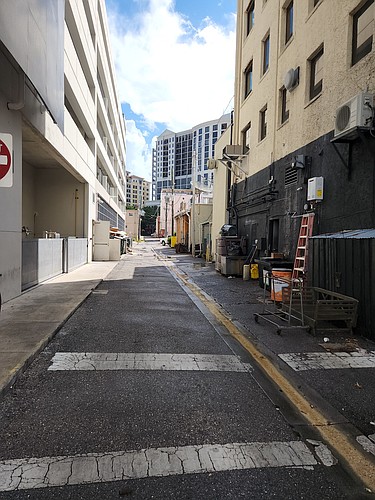- December 20, 2025
-
-
Loading

Loading

Downtown Sarasota’s many alleyways can be dark, dumping grounds for restaurants and merchants. Mayor Erik Arroyo and Senior Planner Mary Davis Wallace, who is the lead for the city’s public arts program, view them as non-utilized potential for art, activities and pleasant pedestrian passages for traversing the arts and entertainment district.
Arroyo and Wallace appeared before the Downtown Improvement District board on Thursday, pitching an alley beautification concept already employed by such cities as Chattanooga and Knoxville, Tennessee; Asheville, North Carolina; and others. There, alleys by day become venues by night by cleaning and painting them, installing art and greenery, stringing overhead lighting and more while still maintaining their utility uses by day.
“Our alleys are not very walkable, and they seem to be dark and sometimes restaurants take that as an excuse to throw trash out there,” Arroyo said while displaying before-and-after images of a rehabbed alley. “After five o'clock we don't have any deliveries, so people can actually have events in these alleys.”
Wallace sees an opportunity to dovetail, if not kickstart, an alley beautification effort within the city’s under-development public art master plan, citing select alleys as potential space for art exhibits and performance art venues.
“I'm really interested to build something into the master plan that looks very similar to a lot of other alley activation programs,” Wallace said. “We’re looking at things like providing some some space for people to walk, understanding that this is lost space. The idea is to provide an opportunity for people to interact. It's a very tight, intimate space.”
The concept of alley beautification was floated in the 1990s, some DID board members told Arroyo and Wallace, but it never gained traction. Among the challenges is buy-in among all businesses on the block to collaborate in shared trash receptacles, among others.
While plenty of due diligence on the concept remain to be done, the action plan first requires identifying an alley for a pilot program. After consolidating solid waste to clear the alley, the next steps may include repaving with bricks, paint, decorating the walls, and adding greenery and lighting.
“Maybe we do some miscellaneous items like benches, bike racks and under-grounding the power lines,” Arroyo said. “Then we repeat, and we have walkable, safe alleys that don't get dumped on. If any of you have been to Greece or to Budapest or to Prague or to France, alley beautification is something that is very prevalent.”
To test the potential community buy-in for the concept, Arroyo said he floated the idea on social media. Within five hours, he said there were more than 50 volunteers plus an architect, landscape architect and construction company offering its services for the pilot alley pro bono. He has discussed burying power lines with Florida Power & Light, he said.
“We need to work on funding and encroachment issues to see if any private property owners have rights of way,” Arroyo said. “We need government oversight because. … They’re going to hold the city responsible for if something goes wrong. We have community buy-in, we need more and we need the consent of the businesses if we're going to paint on their walls.”
Although the alley beautification concept was met with enthusiastic support from the entire DID board, there were some concerns. Chris Voelker, who owns State Street Eating House + Cocktails, which backs up to an alley, cautioned that the alleys are used by large trucks making deliveries, and any physical enhancements would have to maintain adequate width to accommodate them. Because deliveries must end by 5 p.m., alleys are available for evening activities.
As always the devil is in the details, Voelker added.
“This always seems to come in back to maintenance,” Voelker said. “You talked about getting volunteers, and everybody gets excited about a new project, but then there's maintenance. If the city commits to maintaining all the plants, and plants bring other insects, all of that has to be considered.”
All that and more falls under due diligence, which will include conducting an inventory of the alleys in downtown, existing infrastructure and utilities in each, and whether a shared trash-bin program is feasible.
And as always, there’s funding. Arroyo told the board he isn’t seeking money from the DID, at least not yet. For now, buy-in from the board and the businesses it represents is adequate.
Voelker and fellow board member Mark Kauffman said they would support seed funding for the program from the DID budget and asked for the matter to be placed on the August meeting agenda. In the meantime, Wallace said she would bring more details about the program to the discussion.
“I'll need to get with staff just to be sure that we're moving in the right direction,” Wallace said. “We can put stuff together to show you what we could do superficially for the public art program, and then perhaps we can also build in the mayor's ideas for more long-term involvement.”